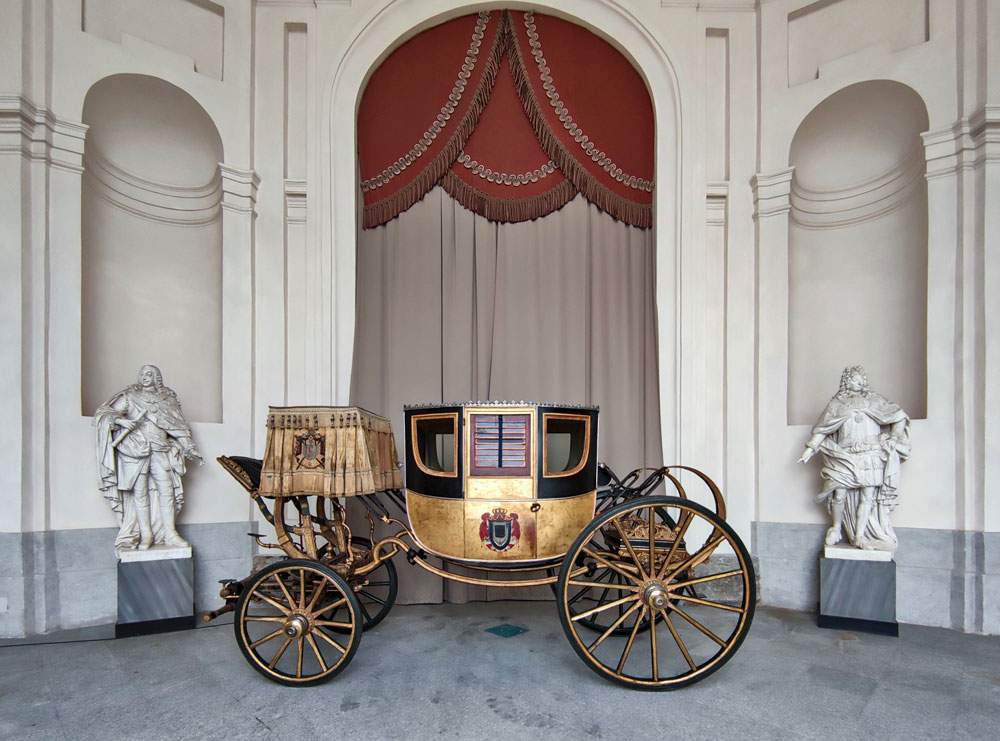Napoleon's carriage on display at the Palace of Venaria
Since May 5, on the occasion of the two hundredth anniversary of Napoleon’s death, Napoleon’s carriage has been on display at the Scuderia Grande of the Reggia di Venaria. The latter was the subject of a thorough restoration carried out by the Laboratories of the Conservation and Restoration Center “La Venaria Reale” and co-financed by the Consortium of the Royal Residences of Savoy, under the high supervision of the Superintendence of Archaeology, Fine Arts and Landscape for the Metropolitan City of Turin.
The carriage had never been the subject of any structured scientific study, which instead led to the discovery of previously unpublished information about its historical events. Made in Paris in the early nineteenth century by Jean-Ernest-Auguste Getting, Napoleon’s coachbuilder, it has been on display at the Marengo Museum for about a century, after various changes of ownership and vicissitudes; since 1955 it has been part of the patrimony of the Ordine Mauriziano Foundation, Palazzina di Caccia di Stupinigi, where it will return in a couple of years. The exhibition is curated by Silvia Ghisotti, chief conservator Consorzio Residenze Reali Sabaude, and Andrea Merlotti, director Centro Studi Consorzio Residenze Reali Sabaude, with the collaboration of Paolo Palumbo, delegate for the City of Turin of “Souvenir Napoléonien.”
Marta Fusi, director of the Palazzina di Caccia di Stupinigi - Fondazione Ordine Mauriziano, said, “’Stupinis qui est à Turin ce qui est Saint Cloud à Paris,’ writes Louis Constant Wairy premier valet de chambre of Napoleon in his Memoirs. The Palazzina di Caccia, a triumph of Juvarra’s architecture and the Savoy dynasty, was carefully chosen by the Emperor as ’sa maison de plaisance’ in Piedmont, as the documentation testifies, which was followed by an economic endowment of 300,000 francs, requesting, then, unique case, its maquette in Paris, to study it at its best, in view of his trip in 1805 to Milan. The albeit brief Napoleonic interlude in Piedmont, which the bicentenary of Napoleon’s death has caused to be rediscovered, is a chapter in the history of the Palazzina that we have been strongly wanting to recount for some years now, thanks also to the presence, precious, of Napoleon’s Carriage. Since 1955, thanks to Gustavo Adolfo Rol’s donation, it has been part of the patrimony of the Mauritian Order; we remember it already exhibited in the ’Gallery of Napoleonic relics’ and described by Mallé ’simple of form, perfect of lines, limpid in the tense profiles ...’. We like to imagine, as Rol, a great lover of the figure of Napoleon, did, that it was among those that, coming down from Moncenisio had brought the imperial couple and court to Stupinigi that famous April of 1805. Today, the Carriage, thanks to the now well-established synergies between the Fondazione Ordine Mauriziano, the Consortium of the Royal Residences of Savoy and, above all, the Venaria Reale Restoration Center, is returning to its splendor, a testament to the long history of the Hunting Lodge, which still has much to tell, and when it returns in two years’ time, it can be an important attraction for the attentive and passionate visitor, of all history.”
The carriage was made around 1805 by Jean-Ernest-Auguste Getting, a Parisian coachbuilder active for Napoleon and his court, to whom we also owe the saloon car used in 1804 for the imperial coronation in Paris. Between 1803 and 1815 he built at least fifteen carriages of different kinds for the emperor, including five gala sedans. Brought from Paris to Italy, it would have been included, according to some, in the re-enactment of the Battle of Marengo (May 5, 1805) and in the procession for Napoleon’s coronation in Milan as king of Italy (May 26). For others, however, it would have been made for the emperor’s marriage to Marie Louise of Austria, celebrated in Paris on April 1 and 2, 1810. This hypothesis seems less likely and would not explain its presence in Italy. After 1815, however, the saloon was in the possession of Maria Luigia, by then Duchess of Parma, who removed Napoleonic symbols and arms and had her new coat of arms affixed to it. Around 1845 the carriage was then purchased by the Alexandria pharmacist Giovanni Antonio Delavo, who was setting up the Napoleonic museum of Marengo in a villa he owned, so he purchased memorabilia from all over Italy. In 1947 the villa was sold to Montedison and the collection was donated to the Alexandria Civic Museum, minus the carriage. Left in Marengo, the sedan passed to Novi Ligure antiquarian Edilio Cavanna; it was later bought by Gustavo Adolfo Rol, a lover of Napoleonic history, who had it restored and tried to find it a worthy location. Through the intervention of the Superintendent of Galleries for Piedmont Noemi Gabrielli, the carriage became the property of the Ente Ordine Mauriziano, which has displayed it in the Palazzina di Caccia in Stupinigi since 1955.
 |
| Napoleon's carriage on display at the Palace of Venaria |
Warning: the translation into English of the original Italian article was created using automatic tools. We undertake to review all articles, but we do not guarantee the total absence of inaccuracies in the translation due to the program. You can find the original by clicking on the ITA button. If you find any mistake,please contact us.



























